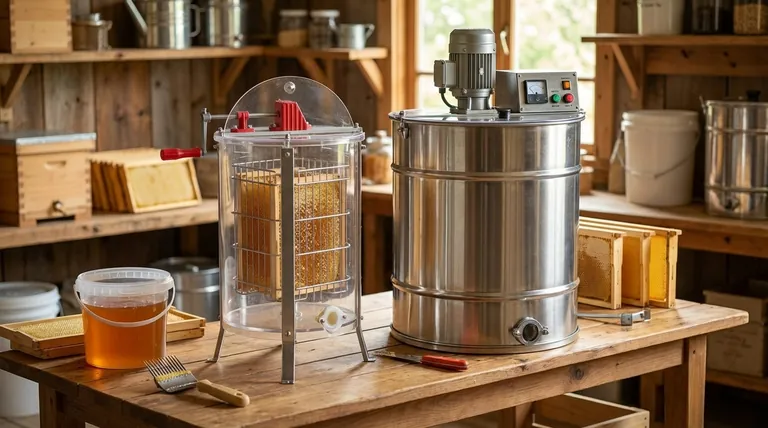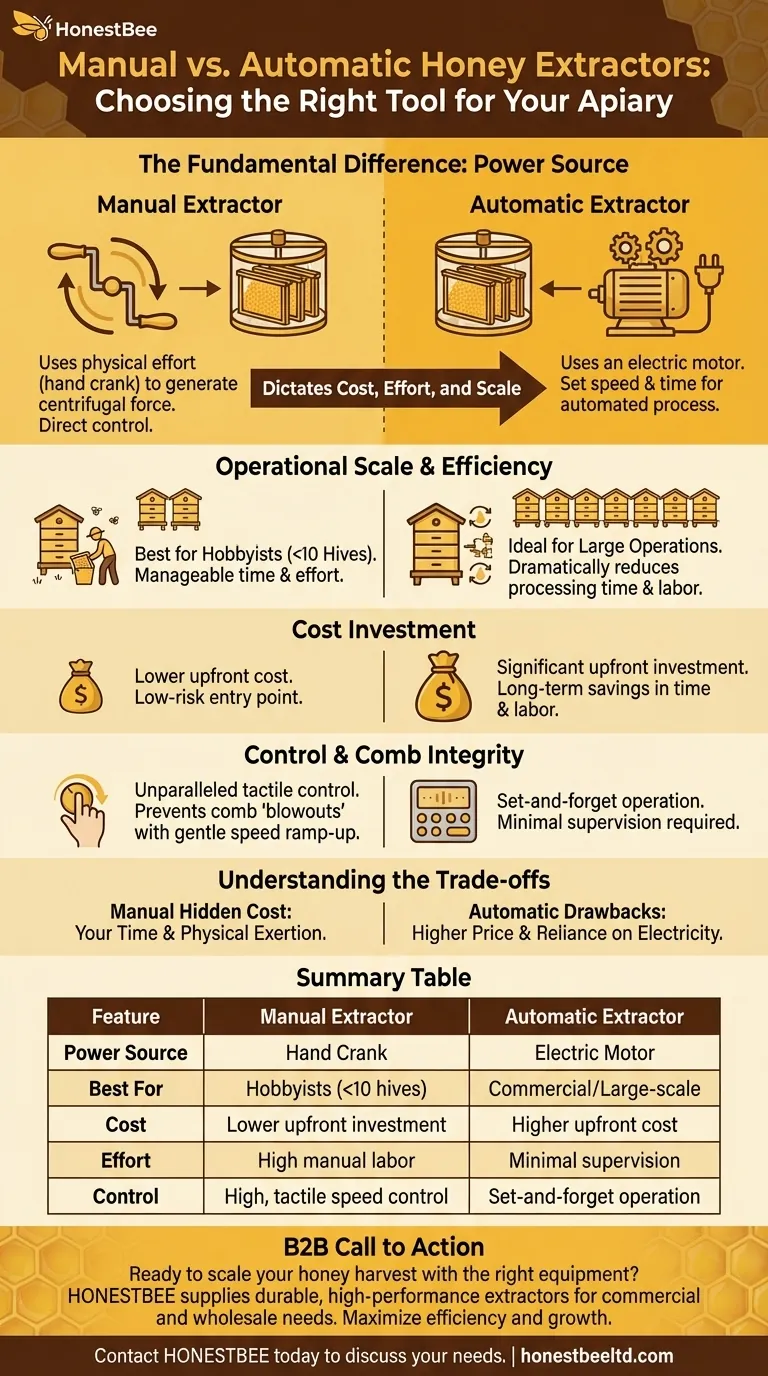The fundamental difference between a manual and an automatic honey extractor is its power source. A manual extractor uses a hand crank that you turn to generate centrifugal force, while an automatic (or electric) extractor uses an electric motor to do the work for you. This single distinction dictates the cost, effort, and scale each machine is suited for.
Choosing between them isn't about which is "better," but which tool aligns with your specific goals. Manual extractors are ideal for hobbyists who value low cost and direct control, while automatic extractors are built for larger operations that prioritize speed and efficiency.

The Core Difference: Power and Effort
The operational mechanics of each extractor type directly impact your time and labor during the honey harvest.
How a Manual Extractor Works
A manual extractor is powered entirely by physical effort. You place the honey-filled frames inside the drum, and then you turn a handle or hand crank.
This rotation creates the centrifugal force needed to pull the honey out of the comb, where it then runs down the walls of the tank to be collected. You have direct, tactile control over the speed and duration of the spin.
How an Automatic Extractor Works
An automatic extractor replaces the hand crank with an electric motor. Once the frames are loaded, you simply set the speed and time, and the machine handles the entire spinning process.
This design significantly reduces manual labor and allows the process to run with minimal supervision, freeing you to perform other tasks like uncapping the next batch of frames.
Comparing Key Factors for Your Apiary
The right choice depends on a clear-eyed assessment of your apiary's size, your budget, and your long-term goals.
Operational Scale and Efficiency
The number of hives you manage is the most critical factor. For beekeepers with just a few hives (typically under ten), the time and effort of a manual extractor are manageable.
For medium to large-scale operations (more than ten hives), an electric extractor becomes a near-necessity. It dramatically reduces processing time, allowing you to extract large quantities of honey far more efficiently.
Cost Investment
Manual extractors are significantly more affordable, making them the default choice for beginners or those on a tight budget. They represent a low-risk entry point into honey extraction.
Automatic extractors are a considerable upfront investment. However, for a growing or commercial operation, this cost is often justified by the massive savings in time and labor over the long term.
Control and Comb Integrity
Manual extractors offer unparalleled control. Because you can feel the resistance, you can gently ramp up the speed, which is crucial for preventing "blowouts" where the delicate wax comb is destroyed by excessive force.
This hands-on approach is often preferred by hobbyists who enjoy being intimately involved in every step of the process.
Understanding the Trade-offs
Neither option is perfect. Being aware of the downsides is key to avoiding frustration.
The Hidden Cost of Manual Extraction: Your Time
While a manual extractor is cheap to buy, its true cost is measured in time and physical exertion. Extracting honey from dozens of frames with a hand crank is a demanding workout and can turn a day of harvesting into a multi-day marathon.
The Dependency of Automatic Extraction: Power and Price
The most obvious drawbacks of an automatic extractor are its higher price and its reliance on electricity. If you work in a remote location without a reliable power source, a manual extractor is your only practical choice.
Making the Right Choice for Your Goal
Select your tool based on a realistic evaluation of your needs, not just on price.
- If your primary focus is a small-scale hobby (fewer than 10 hives): A manual extractor offers an affordable, hands-on experience that connects you directly to the harvest.
- If your primary focus is efficiency and growth: An automatic extractor is a necessary investment that will save you significant time and physical labor as your apiary expands.
- If your primary focus is maximum control and gentleness: A manual extractor gives you the most tactile feedback, allowing you to carefully manage spinning speed to protect your combs.
Ultimately, the right extractor is the one that best serves the scale of your operation and your personal beekeeping philosophy.
Summary Table:
| Feature | Manual Extractor | Automatic Extractor |
|---|---|---|
| Power Source | Hand Crank | Electric Motor |
| Best For | Hobbyists (<10 hives) | Commercial/Large-scale apiaries |
| Cost | Lower upfront investment | Higher upfront cost |
| Effort | High manual labor | Minimal supervision required |
| Control | High, tactile speed control | Set-and-forget operation |
Ready to scale your honey harvest with the right equipment?
Whether you're a commercial apiary or a beekeeping equipment distributor, HONESTBEE supplies the durable, high-performance extractors you need to maximize efficiency. Our wholesale-focused operations provide the tools for growth.
Contact HONESTBEE today to discuss your needs and get a quote on our range of beekeeping supplies and equipment.
Visual Guide

Related Products
- HONESTBEE 3-Frame Manual Acrylic Honey Extractor
- Electric 8 Frame Honey Spinner Extractor Equipment for Beekeeping
- 2 Frame Stainless Steel Manual Honey Spinner Extractor for Beekeeping
- Commercial Electric 12 Frame Honey Extractor Spinner Motorized Honey Extractor
- Stainless Steel 3 Frame Manual Honey Extractor Spinner for Bee Honey Extraction
People Also Ask
- What is a fun and easy alternative to using a honey extractor for harvesting honey? Try the Crush and Strain Method
- What equipment is used for honey harvest? Essential Tools for Every Beekeeper
- What size honey extractor do I need? Match Frame Capacity to Your Hives for Maximum Efficiency
- How do you manually extract honey? Choose the Best Method for Your Hive
- How often do beekeepers collect honey? Maximize Your Hive's Sustainable Yield



















